A proper wheel alignment is necessary to improve the steering experience, stability of the automobile on the road, and the life of the tires, etc. The parameters on which the wheel alignment is based are caster and camber angle, toe-in and toe-out. Thus in this article, we are going to discuss the caster and camber in detail.
In this article, we’re going to discuss:
- What is Caster angle?
1.1. How does caster affect steering? - What is Camber angle?
2.1. How does camber affect steering? - What is the difference between caster and camber angle?
What is Caster angle?
While viewing from the side of the vehicle, the angle made by the axis of the kingpin (steering axis) with a vertical axis of the wheel is known as Caster.
The caster is divided into the following two types:-
- Positive caster angle
- Negative caster angle
Let’s see them in detail.
1] Positive caster angle:-
When the top of the steering axis (kingpin axis) is tilted behind the vertical wheel axis then the angle made by them is known as a Positive caster.
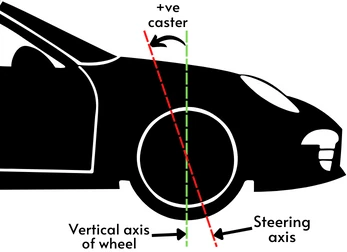
The positive caster angle helps to create directional stability while moving onto the straight road. Let’s see how,
When the vehicle takes a turn while moving on the curved road, the centrifugal force acting on the vehicle tries to throw the vehicle in an outward direction. (shown in the below figure).
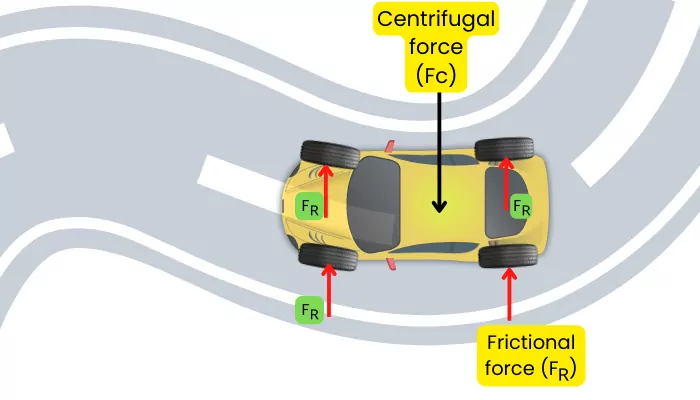
To withstand the vehicle on road, the frictional force between the road and the tire acts opposite to the centrifugal force.
In the case of a positive caster angle, the frictional force acts away from the steering axis.
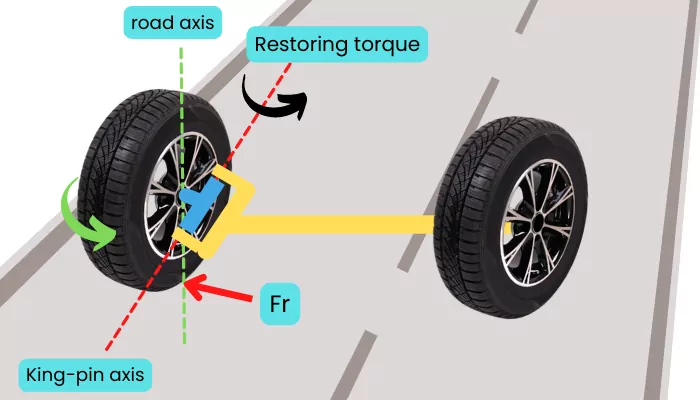
Thus because of the positive caster angle, the frictional force creates restoring torque in the wheel that helps to realign the car’s wheels to the center. This helps the vehicle to run automatically in a straight line after taking a turn.
Generally, the caster angle is allowed up to 2° to 3° for better-restoring torque.
2] Negative caster angle:-
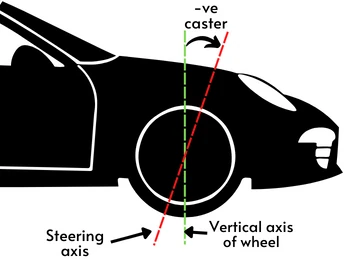
When the top of the steering axis is tilted ahead of the vertical axis then the angle formed between them is known as the Negative caster angle.
How does caster affect steering?
The effects of positive and negative caster angles are as follows:-
1] The positive caster angle causes heavier steering but it also provides the stability while moving on a straight road. The self-aligning torque due to the positive caster restores the steering to the center position after taking the turn.
2] Negative caster makes steering easier but it doesn’t provide stability while moving straight.
What is Camber angle?
Camber is the angle between the vertical axis of the road and the centerline passing through the tire. Due to the camber angle, the less surface of the tire comes in contact with the road, which results in more wear of the tire portion that is in contact with the road.
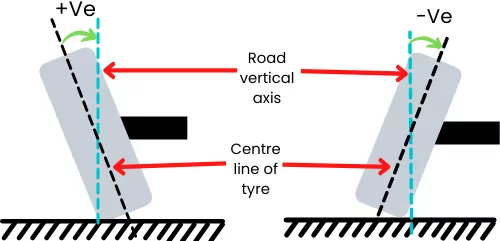
The camber angle can be divided as follows,
- Positive camber angle
- Negative camber angle
Let’s see them in detail.
1] Positive camber angle:-
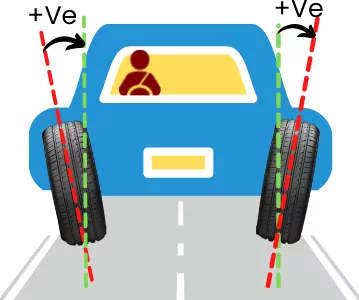
As shown in the above figure, if the upper part of the wheel is tilted outward, then the angle made by the wheel axis (red dotted line) and road axis (green dotted line) is known as the Positive camber angle.
In the case of positive camber, the outward surface of the tire is in more contact with the road. Thus the outward tire surface undergoes more wear.
For most vehicles, the manufacturer provides a positive camber angle.
In such vehicles after the application of load, the camber angle becomes minimum. Thus the centerline of the tire becomes perpendicular to the road and the maximum surface of the tire comes in contact with the road.
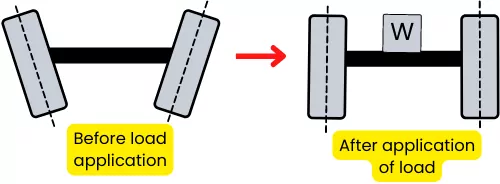
2] Negative camber angle:-

As shown in the above figure, when the upper part of the wheel is tilted inward, then the angle made by the wheel axis (red dotted line) and road axis (green dotted line) is considered as a Negative camber angle.
In this case, the inward surface of the tire is in more contact with the road and therefore the inward surface of the tire undergoes more wear.
In some vehicles, the negative camber is set to increase the stability of vehicles while moving on a curved road.
How does camber affect steering?
The effects of positive and negative camber angles are as follows:-
1] The positive camber angle helps to reduce the efforts required for steering the vehicle.
2] The negative camber is used to increase stability while moving on the curved road. But it lowers the stability for moving on a straight road.
What is the difference between caster and camber angle?
| Sr. No. | Caster | Camber |
|---|---|---|
| 1] | While viewing from the side of a vehicle, the caster is the angle between the steering axis and a vertical axis of the wheel. | While viewing from the front of a vehicle, the camber is the angle made by an axis of the wheel with an axis perpendicular to the road. |
| 2] | The caster angle never affects the life of the tire. | The excessive camber angle reduces the life of a tire. |
| 3] | The positive caster generates restoring torque that helps to return the steering to the center position. | The positive camber angle helps to reduce the steering efforts. |
FAQs:
-
What is the purpose of caster?
The positive caster helps to generate restoring torque into the steering wheel that helps to realign the steering wheels to the center.
-
What happens if caster is off?
When the caster is off then the vehicle becomes unstable while moving straight.
-
Do cars have positive or negative caster?
Modern vehicles are provided with a positive caster angle while a negative caster was used in old vehicles.
-
What happens if camber is off?
If the camber is off then less portion of the tire comes in contact with the road, therefore, the surface of the tire which is in more contact with the road undergoes more wear.
-
Why do cars have negative camber?
The negative camber increases the stability of the vehicle during heavy cornering.
-
Why is positive camber used?
Positive camber is used for reducing the steering efforts.